"How to Analyze a Pharmaceutical Company" on page 158 in Fundamentals of Investment Management by Hirt.
Write a brief one (1) page paper on analyzing a pharmaceutical company.

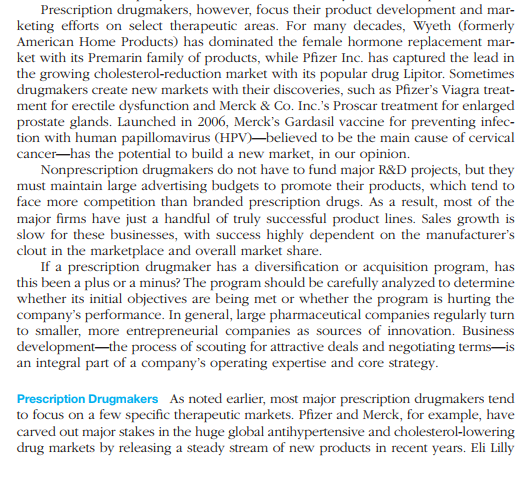
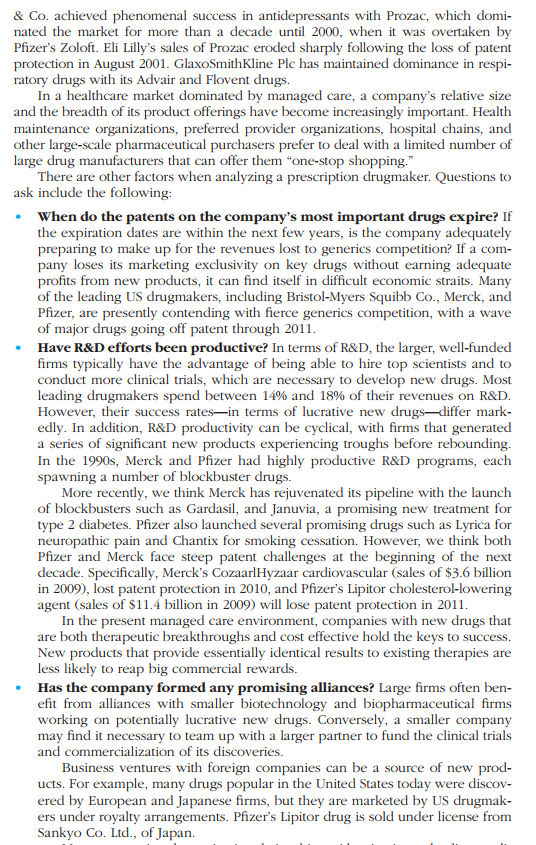
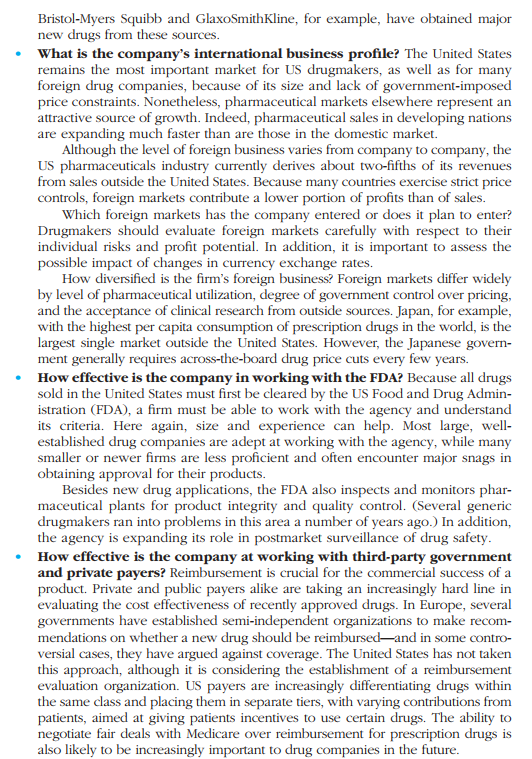
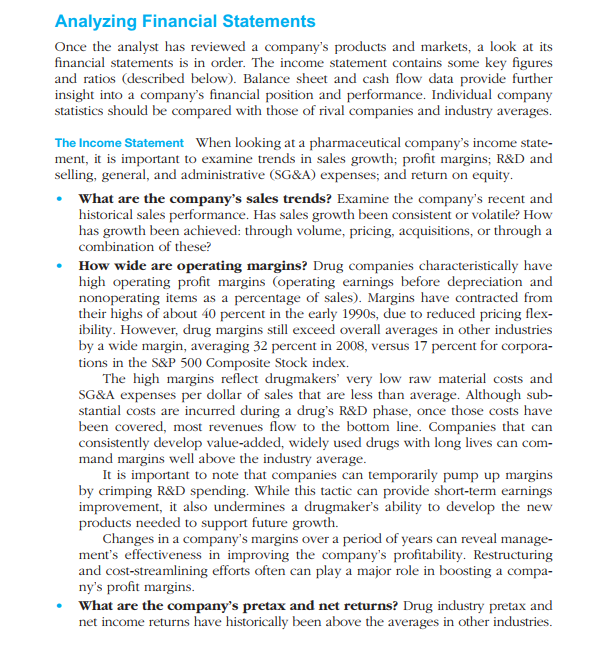
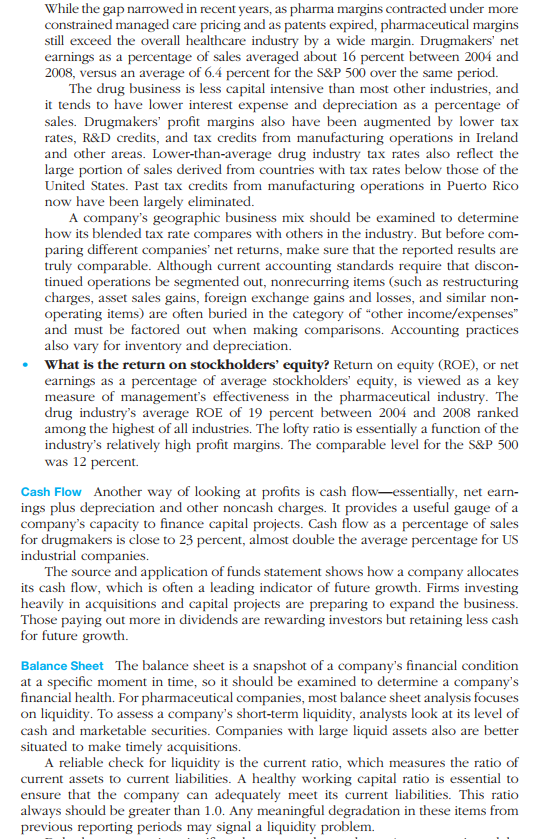
Prescription drugmakers, however, focus their product development and mar- keting efforts on select therapeutic areas. For many decades, Wyeth (formerly American Home Products) has dominated the female hormone replacement mar- ket with its Premarin family of products, while Pfizer Inc. has captured the lead in the growing cholesterol-reduction market with its popular drug Lipitor. Sometimes drugmakers create new markets with their discoveries, such as Pfizer's Viagra treat- ment for erectile dysfunction and Merck & Co. Inc.'s Proscar treatment for enlarged prostate glands. Launched in 2006, Merck's Gardasil vaccine for preventing infec- tion with human papillomavirus (HPV)believed to be the main cause of cervical cancer-has the potential to build a new market, in our opinion. Nonprescription drugmakers do not have to fund major R&D projects, but they must maintain large advertising budgets to promote their products, which tend to face more competition than branded prescription drugs. As a result, most of the major firms have just a handful of truly successful product lines. Sales growth is slow for these businesses, with success highly dependent on the manufacturer's clout in the marketplace and overall market share. If a prescription drugmaker has a diversification or acquisition program, has this been a plus or a minus? The program should be carefully analyzed to determine whether its initial objectives are being met or whether the program is hurting the company's performance. In general, large pharmaceutical companies regularly turn to smaller, more entrepreneurial companies as sources of innovation. Business developmentthe process of scouting for attractive deals and negotiating termsis an integral part of a company's operating expertise and core strategy. Prescription Drugmakers As noted earlier, most major prescription drugmakers tend to focus on a few specific therapeutic markets. Pfizer and Merck, for example, have carved out major stakes in the huge global antihypertensive and cholesterol-lowering drug markets by releasing a steady stream of new products in recent years. Eli Lilly Prescription drugmakers, however, focus their product development and mar- keting efforts on select therapeutic areas. For many decades, Wyeth (formerly American Home Products) has dominated the female hormone replacement mar- ket with its Premarin family of products, while Pfizer Inc. has captured the lead in the growing cholesterol-reduction market with its popular drug Lipitor. Sometimes drugmakers create new markets with their discoveries, such as Pfizer's Viagra treat- ment for erectile dysfunction and Merck & Co. Inc.'s Proscar treatment for enlarged prostate glands. Launched in 2006, Merck's Gardasil vaccine for preventing infec- tion with human papillomavirus (HPV)believed to be the main cause of cervical cancer-has the potential to build a new market, in our opinion. Nonprescription drugmakers do not have to fund major R&D projects, but they must maintain large advertising budgets to promote their products, which tend to face more competition than branded prescription drugs. As a result, most of the major firms have just a handful of truly successful product lines. Sales growth is slow for these businesses, with success highly dependent on the manufacturer's clout in the marketplace and overall market share. If a prescription drugmaker has a diversification or acquisition program, has this been a plus or a minus? The program should be carefully analyzed to determine whether its initial objectives are being met or whether the program is hurting the company's performance. In general, large pharmaceutical companies regularly turn to smaller, more entrepreneurial companies as sources of innovation. Business developmentthe process of scouting for attractive deals and negotiating termsis an integral part of a company's operating expertise and core strategy. Prescription Drugmakers As noted earlier, most major prescription drugmakers tend to focus on a few specific therapeutic markets. Pfizer and Merck, for example, have carved out major stakes in the huge global antihypertensive and cholesterol-lowering drug markets by releasing a steady stream of new products in recent years. Eli Lilly & Co. achieved phenomenal success in antidepressants with Prozac, which domi- nated the market for more than a decade until 2000, when it was overtaken by Pfizer's Zoloft. Eli Lilly's sales of Prozac eroded sharply following the loss of patent protection in August 2001. GlaxoSmithKline Plc has maintained dominance in respi- ratory drugs with its Advair and Flovent drugs. In a healthcare market dominated by managed care, a company's relative size and the breadth of its product offerings have become increasingly important. Health maintenance organizations, preferred provider organizations, hospital chains, and other large-scale pharmaceutical purchasers prefer to deal with a limited number of large drug manufacturers that can offer them one-stop shopping." There are other factors when analyzing a prescription drugmaker. Questions to ask include the following: When do the patents on the company's most important drugs expire? If the expiration dates are within the next few years, is the company adequately preparing to make up for the revenues lost to generics competition? If a com- pany loses its marketing exclusivity on key drugs without earning adequate profits from new products, it can find itself in difficult economic straits. Many of the leading US drugmakers, including Bristol-Myers Squibb Co., Merck, and Pfizer, are presently contending with fierce generics competition, with a wave of major drugs going off patent through 2011. Have R&D efforts been productive? In terms of R&D, the larger, well-funded firms typically have the advantage of being able to hire top scientists and to conduct more clinical trials, which are necessary to develop new drugs. Most leading drugmakers spend between 14% and 18% of their revenues on R&D. However, their success rates in terms of lucrative new drugsdiffer mark- edly. In addition, R&D productivity can be cyclical, with firms that generated a series of significant new products experiencing troughs before rebounding. In the 1990s, Merck and Pfizer had highly productive R&D programs, each spawning a number of blockbuster drugs. More recently, we think Merck has rejuvenated its pipeline with the launch of blockbusters such as Gardasil, and Januvia, a promising new treatment for type 2 diabetes. Pfizer also launched several promising drugs such as Lyrica for neuropathic pain and Chantix for smoking cessation. However, we think both Pfizer and Merck face steep patent challenges at the beginning of the next decade. Specifically, Merck's CozaarlHyzaar cardiovascular (sales of $3.6 billion in 2009), lost patent protection in 2010, and Pfizer's Lipitor cholesterol-lowering agent (sales of $11.4 billion in 2009) will lose patent protection in 2011. In the present managed care environment, companies with new drugs that are both therapeutic breakthroughs and cost effective hold the keys to success. New products that provide essentially identical results to existing therapies are less likely to reap big commercial rewards. Has the company formed any promising alliances? Large firms often ben- efit from alliances with smaller biotechnology and biopharmaceutical firms working on potentially lucrative new drugs. Conversely, a smaller company may find it necessary to team up with a larger partner to fund the clinical trials and commercialization of its discoveries. Business ventures with foreign companies can be a source of new prod- ucts. For example, many drugs popular in the United States today were discov- ered by European and Japanese firms, but they are marketed by US drugmak- ers under royalty arrangements. Pfizer's Lipitor drug is sold under license from Sankyo Co. Ltd., of Japan. Bristol-Myers Squibb and GlaxoSmithKline, for example, have obtained major new drugs from these sources. What is the company's international business profile? The United States remains the most important market for US drugmakers, as well as for many foreign drug companies, because of its size and lack of government-imposed price constraints. Nonetheless, pharmaceutical markets elsewhere represent an attractive source of growth. Indeed, pharmaceutical sales in developing nations are expanding much faster than are those in the domestic market. Although the level of foreign business varies from company to company, the US pharmaceuticals industry currently derives about two-fifths of its revenues from sales outside the United States. Because many countries exercise strict price controls, foreign markets contribute a lower portion of profits than of sales. Which foreign markets has the company entered or does it plan to enter? Drugmakers should evaluate foreign markets carefully with respect to their individual risks and profit potential. In addition, it is important to assess the possible impact of changes in currency exchange rates. How diversified is the firm's foreign business? Foreign markets differ widely by level of pharmaceutical utilization, degree of government control over pricing, and the acceptance of clinical research from outside sources. Japan, for example, with the highest per capita consumption of prescription drugs in the world, is the largest single market outside the United States. However, the Japanese govern- ment generally requires across-the-board drug price cuts every few years. How effective is the company in working with the FDA? Because all drugs sold in the United States must first be cleared by the US Food and Drug Admin- istration (FDA), a firm must be able to work with the agency and understand its criteria. Here again, size and experience can help. Most large, well- established drug companies are adept at working with the agency, while many smaller or newer firms are less proficient and often encounter major snags in obtaining approval for their products. Besides new drug applications, the FDA also inspects and monitors phar- maceutical plants for product integrity and quality control. (Several generic drugmakers ran into problems in this area a number of years ago.) In addition, the agency is expanding its role in postmarket surveillance of drug safety. How effective is the company at working with third-party government and private payers? Reimbursement is crucial for the commercial success of a product. Private and public payers alike are taking an increasingly hard line in evaluating the cost effectiveness of recently approved drugs. In Europe, several governments have established semi-independent organizations to make recom- mendations on whether a new drug should be reimbursedand in some contro- versial cases, they have argued against coverage. The United States has not taken this approach, although it is considering the establishment of a reimbursement evaluation organization. US payers are increasingly differentiating drugs within the same class and placing them in separate tiers, with varying contributions from patients, aimed at giving patients incentives to use certain drugs. The ability to negotiate fair deals with Medicare over reimbursement for prescription drugs is also likely to be increasingly important to drug companies in the future. Analyzing Financial Statements Once the analyst has reviewed a company's products and markets, a look at its financial statements is in order. The income statement contains some key figures and ratios (described below). Balance sheet and cash flow data provide further insight into a company's financial position and performance. Individual company statistics should be compared with those of rival companies and industry averages. The Income Statement When looking at a pharmaceutical company's income state- ment, it is important to examine trends in sales growth; profit margins; R&D and selling, general, and administrative (SG&A) expenses, and return on equity. What are the company's sales trends? Examine the company's recent and historical sales performance. Has sales growth been consistent or volatile? How has growth been achieved: through volume, pricing, acquisitions, or through a combination of these? How wide are operating margins? Drug companies characteristically have high operating profit margins (operating earnings before depreciation and nonoperating items as a percentage of sales). Margins have contracted from their highs of about 40 percent in the early 1990s, due to reduced pricing flex- ibility. However, drug margins still exceed overall averages in other industries by a wide margin, averaging 32 percent in 2008, versus 17 percent for corpora- tions in the S&P 500 Composite Stock index. The high margins reflect drugmakers' very low raw material costs and SG&A expenses per dollar of sales that are less than average. Although sub- stantial costs are incurred during a drug's R&D phase, once those costs have been covered, most revenues flow to the bottom line. Companies that can consistently develop value-added, widely used drugs with long lives can com- mand margins well above the industry average. It is important to note that companies can temporarily pump up margins by crimping R&D spending. While this tactic can provide short-term earnings improvement, it also undermines a drugmaker's ability to develop the new products needed to support future growth. Changes in a company's margins over a period of years can reveal manage- ment's effectiveness in improving the company's profitability. Restructuring and cost-streamlining efforts often can play a major role in boosting a compa- ny's profit margins. What are the company's pretax and net returns? Drug industry pretax and net income returns have historically been above the averages in other industries. While the gap narrowed in recent years, as pharma margins contracted under more constrained managed care pricing and as patents expired, pharmaceutical margins still exceed the overall healthcare industry by a wide margin. Drugmakers' net earnings as a percentage of sales averaged about 16 percent between 2004 and 2008, versus an average of 6.4 percent for the S&P 500 over the same period. The drug business is less capital intensive than most other industries, and it tends to have lower interest expense and depreciation as a percentage of sales. Drugmakers' profit margins also have been augmented by lower tax rates, R&D credits, and tax credits from manufacturing operations in Ireland and other areas. Lower-than-average drug industry tax rates also reflect the large portion of sales derived from countries with tax rates below those of the United States. Past tax credits from manufacturing operations in Puerto Rico now have been largely eliminated. A company's geographic business mix should be examined to determine how its blended tax rate compares with others in the industry. But before com- paring different companies' net returns, make sure that the reported results are truly comparable. Although current accounting standards require that discon- tinued operations be segmented out, nonrecurring items (such as restructuring charges, asset sales gains, foreign exchange gains and losses, and similar non- operating items) are often buried in the category of other income/expenses." and must be factored out when making comparisons. Accounting practices also vary for inventory and depreciation. What is the return on stockholders' equity? Return on equity (ROE), or net earnings as a percentage of average stockholders' equity, is viewed as a key measure of management's effectiveness in the pharmaceutical industry. The drug industry's average ROE of 19 percent between 2004 and 2008 ranked among the highest of all industries. The lofty ratio is essentially a function of the industry's relatively high profit margins. The comparable level for the S&P 500 was 12 percent. Cash Flow Another way of looking at profits is cash flow-essentially, net earn- ings plus depreciation and other noncash charges. It provides a useful gauge of a company's capacity to finance capital projects. Cash flow as a percentage of sales for drugmakers is close to 23 percent, almost double the average percentage for US industrial companies. The source and application of funds statement shows how a company allocates its cash flow, which is often a leading indicator of future growth. Firms investing heavily in acquisitions and capital projects are preparing to expand the business. Those paying out more in dividends are rewarding investors but retaining less cash for future growth. Balance Sheet The balance sheet is a snapshot of a company's financial condition at a specific moment in time, so it should be examined to determine a company's financial health. For pharmaceutical companies, most balance sheet analysis focuses on liquidity. To assess a company's short-term liquidity, analysts look at its level of cash and marketable securities. Companies with large liquid assets also are better situated to make timely acquisitions. A reliable check for liquidity is the current ratio, which measures the ratio of current assets to current liabilities. A healthy working capital ratio is essential to ensure that the company can adequately meet its current liabilities. This ratio always should be greater than 1.0. Any meaningful degradation in these items from previous reporting periods may signal a liquidity












